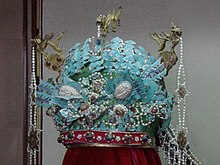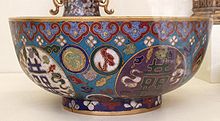
Cloisonné is an ancient technique for decorating metalwork objects, in recent centuries using vitreous enamel, and in older periods also inlays of cut gemstones, glass, and other materials. The resulting objects can also be called cloisonné. The decoration is formed by first adding compartments (cloisons in French[1]) to the metal object by soldering or glueing silver or gold wires or thin strips placed on their edges. These remain visible in the finished piece, separating the different compartments of the enamel or inlays, which are often of several colors. Cloisonné enamel objects are worked on with enamel powder made into a paste, which then needs to be fired in a kiln.
The technique was in ancient times mostly used for jewellery and small fittings for clothes, weapons or similar small objects decorated with geometric or schematic designs, with thick cloison walls. In the Byzantine Empire techniques using thinner wires were developed to allow more pictorial images to be produced, mostly used for religious images and jewellery, and now always using enamel. By the 14th century this enamel technique had spread to China, where it was soon used for much larger vessels such as bowls and vases; the technique remains common in China to the present day, and cloisonné enamel objects using Chinese-derived styles were produced in the West from the 18th century.
Cloisonné enamel
The earliest surviving cloisonné pieces are rings in graves from 12th century BC Cyprus, using very thin wire.[9] Subsequently enamel was just one of the fillings used for the small thick-walled small cloisons of the Late Antique and Migration Period style described above. From about the 8th century, Byzantine art began again to use much thinner wire more freely to allow much more complex designs to be used, with larger and less geometric compartments, which was only possible using enamel.[10] These were still on relatively small objects, although numbers of plaques could be set into larger objects, such as the Pala d'Oro, the altarpiece in Saint Mark's Cathedral, Venice. Some objects combined thick and thin cloisons for varied effect.[11] The designs often (as at right) contained a generous background of plain gold, as in contemporary Byzantine mosaics. The area to be enamelled was stamped to create the main depression, pricked to help the enamel adhere, and the cloisons added.[12]
From Byzantium or the Islamic world the technique reached China in the 13-14th centuries; the first written reference is in a book of 1388, where it is called "Dashi ('Muslim') ware". No Chinese pieces clearly from the 14th century are known, the earliest datable pieces being from the reign of the Xuande Emperor (1425-35), which however show a full use of Chinese styles suggesting considerable experience in the technique.[13] It was initially regarded with suspicion by Chinese connoisseurs, firstly as being foreign, and secondly as appealing to feminine taste. However by the beginning of the 18th century the Kangxi Emperor had a cloisonné workshop among the many Imperial factories. The most elaborate and highly-valued Chinese pieces are from the early Ming Dynasty, especially the reigns of the Xuande Emperor and Jingtai Emperor (1450-57), although 19th century or modern pieces are far more common. The Chinese industry seems to have benefited from a number of skilled Byzantine refugees fleeing the Fall of Constantinople in 1453. In Chinese cloisonné blue is usually the predominant colour, and the Chinese name for the technique, jingtailan ("Jingtai blue ware"), refers to this, and the Jingtai Emperor. Quality began to decline in the 19th century. Initially heavy bronze or brass bodies were used, and the wires soldered, but later much lighter copper vessels were used, and the wire glued on before firing.[14][15]
In Byzantine pieces, and even more in Chinese work, the wire by no means always encloses a separate color of enamel. Sometime a wire is used just for decorative effect, stopping in the middle of a field of enamel, and sometimes the boundary between two enamel colors is not marked by a wire. In the Byzantine plaque at right the first feature may be seen in the top wire on the saint's black sleeve, and the second in the white of his eyes and collar. Both are also seen in the Chinese bowl illustrated at top right.
|
Qing Dynasty cloisonné dish |

A Chinese cloisonne stupa dated to the reign of the Qianlong Emperor (1735-1796) |
Ming Dynasty cloisonné enamel bowl, using nine colors of enamel. |
|
Address: ROOM 103, No 10 Ti Yu Guan Rd, Chongwen District, Beijing
copyright@2010北京百达旅游有限公司






